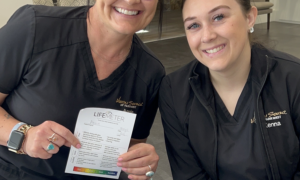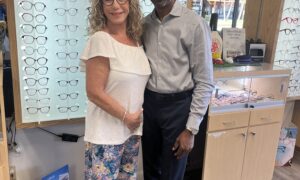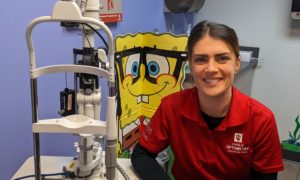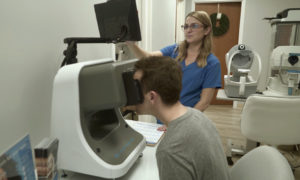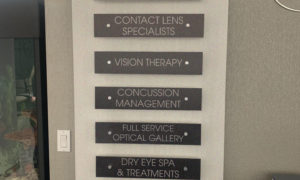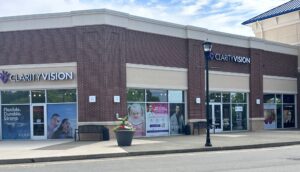
The outside of Dr. Holler’s office. Dr. Holler says a few key technology investments have improved what the practice can do for patients and how much profitability can be gained.
Technology that changes everything for the better.
By David Holler, OD, FAAO, FSLS
April 10, 2024
The right practice investments can transform care and the patient experience, and practice profitability too. Here are a few that did wonders for both us and our patients.
Digital Retinal Imaging Equipment
In 2009, we invested in our first digital retinal screening machine, an Optos.
Our goal was that every patient getting an eye exam would receive the most comprehensive exam possible. As a practice with an emphasis on contact lenses, dilation is low on the priority list in the minds of many of our patients. We give them the choice of Optos or dilation.
Optos is presented as an option where dilation MAY be deferred if we have good images. Most patients like that we give the choice and don’t force dilation. While Optos imaging is very profitable to the practice, the benefits are farther reaching by positioning our practice as one that is more technology forward and sensitive to the many patients who hate dilation.
Editor’s Note: There are other digital retinal screening instruments to choose from, including Optovue, ZEISS Retinal Cameras and the iCare EIDON, among other options.
Cost: The cost of this technology has come down since 2009, and has also improved significantly since that time. We paid around $84,000 for the first and second machine a few years later, but paid $120,000 for two machines in 2022 (so we can have one in each of our pre-testing rooms).
Our current machines were paid for using a credit card. We received loads of rewards points, and paid the balance using reserves we had in the bank.
ROI: Around 60+ percent of our patients elect for routine imaging, and we see an average of 800-900 patients per month. At $39 per image, we paid off two machines within eight months.
We review the images with each patient that elects Optos over dilation (some choose both, especially diabetics who come in expecting to be dilated). We take a moment to review what we are looking for and sometimes show the patient examples of retinopathy, RD, etc, on actual patients in our practice. We find things that were never mentioned to the patient when dilated in the past (by us or other doctors). Peripheral hemorrhages are much easier to see in Optos than dilation.
Other Articles to Explore
The finances are not really a motivating factor for us, but it is easy passive income because it is good for the patient, it elevates our practice and there is virtually zero cost of goods to perform these images once the machine is paid off.
In addition, digital retinal imaging demonstrates more value in receiving comprehensive exams. There are many emmetropes and presbyopes who never get comprehensive eye exams. Reviewing images with a patient often prompts them to schedule a family member with good vision, but no recent exam.
Patient Recall Software
Recall is one of the most important aspects of your practice. Good recall drives better patient outcomes. Patients expect the practice to let them know when it’s time to come in. The best patient outcomes will promote more referrals and a healthier business.
For those reasons, we use automated recall technology from Solutionreach.
Editor’s note: Editor’s Note: Solutionreach is one of many platforms you can choose from for patient communications. Other options include Weave, Constant Contact, Simplifeye and Demandforce, among other options.
There is a whole menu of services available through most patient recall systems. Most offer e-mail, text and phone call reminders. Our system also includes text-to-pay options, ability to exchange texts with our patients, a LIVE online scheduler (which is a huge convenience for patients) and patient reviews/reputation management, etc.
Cost: We pay around $250 per location for the bundled array of services.
ROI: The system helps remind the patient of their appointment. By keeping patients on schedule they are less likely to over-wear their contact lenses. They are also less likely to go unchecked for diabetic retinopathy. Better patient outcomes makes our office better.
This technology keeps our exam slots filled. Keeping the schedule full is an excellent driver of a profitable practice.
While practices are understandably averse to cost, I would recommend negotiating a trial period to trying the full portfolio of services within the technology. Evaluate the usage of these various services, and consider dropping services that you don’t see value in keeping.
Busy practices don’t have time to oversee every team member. There are going to be certain responsibilities that will fall by the wayside. Some team members will always take the shortest path between two points.
Keeping the schedule filled is the number one driver of the fiscal health of the practice. If there is an opportunity to automate this process, then every practice should take advantage of it and monitor it closely.
Edger
We added an edger within the first 2-3 years in practice. Our current edger was purchased from Essilor.
Editor’s Note: There are many lens edgers to choose from. Other options include those from Santinelli , Visionix and Coburn Technologies, among others.
As a busy contact lens practice, we inevitably have patients with over-wear issues. Many of these patients do not have current glasses. An in-office edger gives the practice the opportunity to provider faster service to patients who are desperate.
In around 2010, we paid about $15,000 for a very reliable used edger. In around 2014, we bought a new unit (somewhere around $35,000). Our Essilor rep wanted to make sure we were ordering lenses from them, so they paid the monthly bill for three years as long as we were buying the lenses from them.
ROI is tough to calculate here because many of these purchases are tied to faster turnaround to save the sale. However, if a faster turnaround saves the patient from buying online, or going elsewhere, then it keeps the patient more tied to the practice.
Plus, cost of goods is reduced with every job. Be consistent with how many jobs you edge per month and keep your team motivated to keep these jobs in-house. If done effectively, you could be profitable within six months. Our optical team has incentives to edge around 120 pairs of glasses per month.
An additional benefit of edging in-office for us has been to allow flexibility of hours worked. We do most of our edging two hours before we start patient care. This allows one of our opticians the opportunity to come to work early and leave early. It allows us a way to stagger optician coverage.
My nephew edged for the office for a period of time, too. He would work his regular job 4 p.m. to midnight, and then come in and edge for a few hours until 3- 4 a.m.
There are also opportunities to sell higher-quality lenses by having an edger. If an office struggles to sell anything other than uncoated CR39, you can inventory AR coated poly or trivex. Then, patients who want faster service are forced to get a better-quality lens.
 David Holler, OD, FAAO, FSLS, is President of Clarity Vision of Apex in Apex, N.C. To contact him: dholler@findclarityvision.com
David Holler, OD, FAAO, FSLS, is President of Clarity Vision of Apex in Apex, N.C. To contact him: dholler@findclarityvision.com





